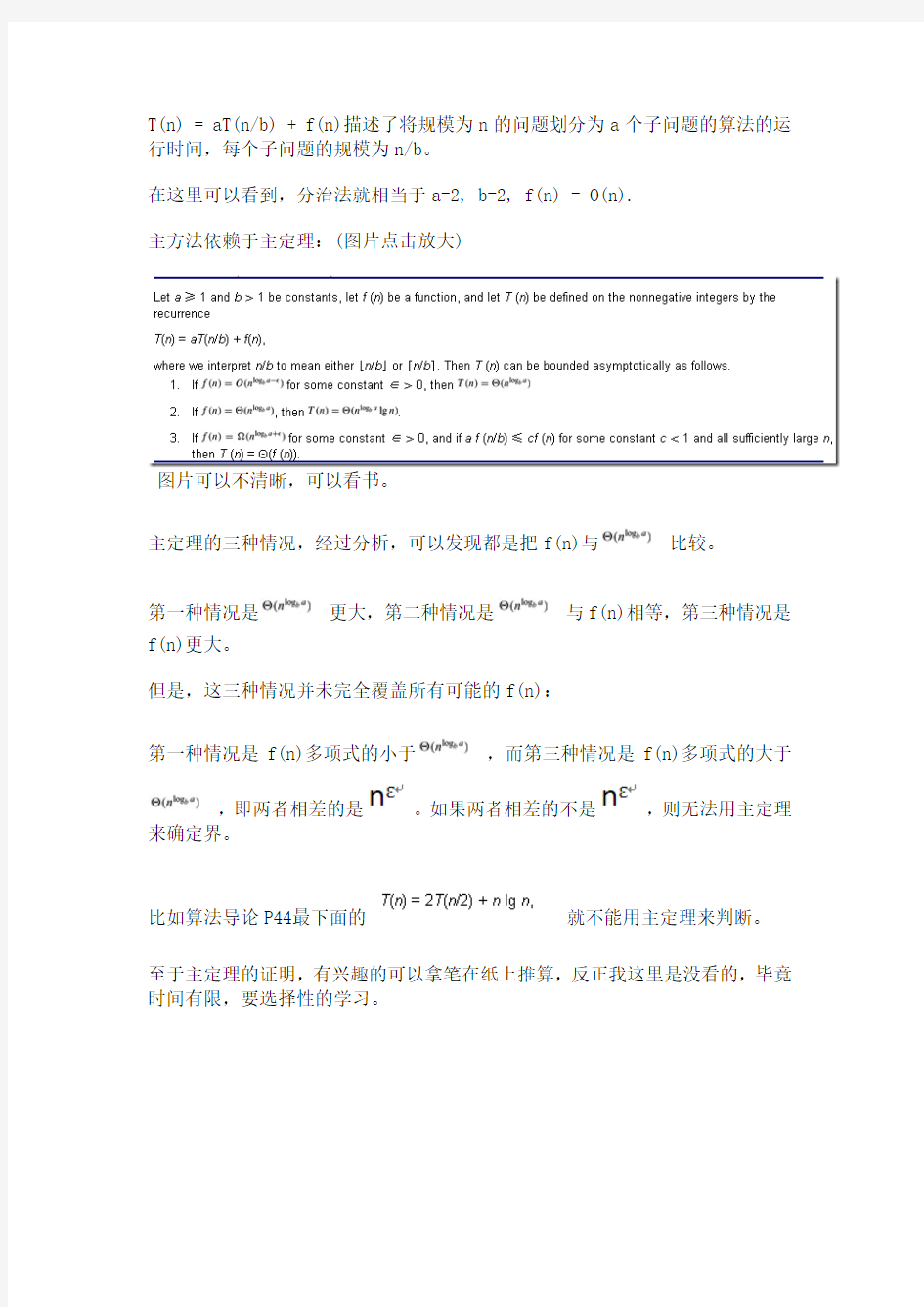算法导论第四章


算法导论第四章
摘自:百度文库
https://www.360docs.net/doc/a615503791.html,/link?url=QunHIQ6sgLN_uMads3Llc8mtkAKSkrn4OI9SuM_g3Tj_0a5N 2fkRVV03F9-iiPOgdcm7zAj54KToWqfeFvNffHr-WaJpeqXzWkDRzewxuhm
https://www.360docs.net/doc/a615503791.html,/tanky-woo/archive/2011/04/12/144020.html
这一章讲的是递归式(recurrence),递归式是一组等式或不等式,它所描述的函数是用在更小的输入下该函数的值来定义的。
本章讲了三种方法来解递归式,分别是代换法,递归树方法,主方法。
1.代换法(Substitution method)(P38~P40)
定义:即在归纳假设时,用所猜测的值去代替函数的解。
用途:确定一个递归式的上界或下界。
缺点:只能用于解的形式很容易猜的情形。
总结:这种方法需要经验的积累,可以通过转换为先前见过的类似递归式来求解。
2.递归树方法(Recursion-tree method)
起因:代换法有时很难得到一个正确的好的猜测值。
用途:画出一个递归树是一种得到好猜测的直接方法。
分析(重点):在递归树中,每一个结点都代表递归函数调用集合中一个子问题的代价。将递归树中每一层内的代价相加得到一个每层代价的集合,再将每层的代价相加得到递归式所有层次的总代价。
总结:递归树最适合用来产生好的猜测,然后用代换法加以验证。
递归树扩展过程:①.第二章2.3.2节分析分治法时图2-5(P21~P22)的构造递归树过程;②.第四章P41图4-1的递归树构造过程;这两个图需要好好分析。
3.主方法(Master method)
优点:针对形如T(n) = aT(n/b) + f(n)的递归式
缺点:并不能解所有形如上式的递归式的解。
具体分析:
T(n) = aT(n/b) + f(n)描述了将规模为n的问题划分为a个子问题的算法的运行时间,每个子问题的规模为n/b。
在这里可以看到,分治法就相当于a=2, b=2, f(n) = O(n).
主方法依赖于主定理:(图片点击放大)
图片可以不清晰,可以看书。
主定理的三种情况,经过分析,可以发现都是把f(n)与比较。
第一种情况是更大,第二种情况是与f(n)相等,第三种情况是f(n)更大。
但是,这三种情况并未完全覆盖所有可能的f(n):
第一种情况是f(n)多项式的小于,而第三种情况是f(n)多项式的大于
,即两者相差的是。如果两者相差的不是,则无法用主定理来确定界。
比如算法导论P44最下面的就不能用主定理来判断。
至于主定理的证明,有兴趣的可以拿笔在纸上推算,反正我这里是没看的,毕竟时间有限,要选择性的学习。
算法导论参考 答案
第二章算法入门 由于时间问题有些问题没有写的很仔细,而且估计这里会存在不少不恰当之处。另,思考题2-3 关于霍纳规则,有些部分没有完成,故没把解答写上去,我对其 c 问题有疑问,请有解答方法者提供个意见。 给出的代码目前也仅仅为解决问题,没有做优化,请见谅,等有时间了我再好好修改。 插入排序算法伪代码 INSERTION-SORT(A) 1 for j ← 2 to length[A] 2 do key ←A[j] 3 Insert A[j] into the sorted sequence A[1..j-1] 4 i ←j-1 5 while i > 0 and A[i] > key 6 do A[i+1]←A[i] 7 i ←i ? 1 8 A[i+1]←key C#对揑入排序算法的实现: public static void InsertionSort
算法导论习题答案
Chapter2 Getting Start 2.1 Insertion sort 2.1.2 将Insertion-Sort 重写为按非递减顺序排序 2.1.3 计算两个n 位的二进制数组之和 2.2 Analyzing algorithms 当前n-1个元素排好序后,第n 个元素已经是最大的元素了. 最好时间和最坏时间均为2()n Θ 2.3 Designing algorithms 2.3.3 计算递归方程的解 22()2(/2)2,1k if n T n T n n if n for k =?=?+ = >? (1) 当1k =时,2n =,显然有()lg T n n n = (2) 假设当k i =时公式成立,即()lg 2lg 22i i i T n n n i ===?, 则当1k i =+,即12i n +=时, 2.3.4 给出insertion sort 的递归版本的递归式 2.3-6 使用二分查找来替代insertion-sort 中while 循环内的线性扫描,是否可以将算法的时间提高到(lg )n n Θ? 虽然用二分查找法可以将查找正确位置的时间复杂度降下来,但
是移位操作的复杂度并没有减少,所以最坏情况下该算法的时间复杂度依然是2()n Θ 2.3-7 给出一个算法,使得其能在(lg )n n Θ的时间内找出在一个n 元素的整数数组内,是否存在两个元素之和为x 首先利用快速排序将数组排序,时间(lg )n n Θ,然后再进行查找: Search(A,n,x) QuickSort(A,n); i←1; j←n; while A[i]+A[j]≠x and i
算法导论 第三版 第35章 答案 英
Chapter35 Michelle Bodnar,Andrew Lohr April12,2016 Exercise35.1-1 We could select the graph that consists of only two vertices and a single edge between them.Then,the approximation algorithm will always select both of the vertices,whereas the minimum vertex cover is only one vertex.more generally,we could pick our graph to be k edges on a graph with2k vertices so that each connected component only has a single edge.In these examples,we will have that the approximate solution is o?by a factor of two from the exact one. Exercise35.1-2 It is clear that the edges picked in line4form a matching,since we can only pick edges from E ,and the edges in E are precisely those which don’t share an endpoint with any vertex already in C,and hence with any already-picked edge. Moreover,this matching is maximal because the only edges we don’t include are the ones we removed from E .We did this because they shared an endpoint with an edge we already picked,so if we added it to the matching it would no longer be a matching. Exercise35.1-3 We will construct a bipartite graph with V=R∪L.We will try to construct it so that R is uniform,not that R is a vertex cover.However,we will make it so that the heuristic that the professor(professor who?)suggests will cause us to select all the vertices in L,and show that|L|>2|R|. Initially start o?with|R|=n?xed,and L empty.Then,for each i from 2up to n,we do the following.Let k= n i .Select S a subset of the vertices of R of size ki,and so that all the vertices in R?S have a greater or equal degree.Then,we will add k vertices to L,each of degree i,so that the union of their neighborhoods is S.Note that throughout this process,the furthest apart the degrees of the vertices in R can be is1,because each time we are picking the smallest degree vertices and increasing their degrees by1.So,once this has been done for i=n,we can pick a subset of R whose degree is one less than the rest of R(or all of R if the degrees are all equal),and for each vertex in 1
算法导论 课后题答案
Partial Solutions for Introduction to algorithms second edition Professor: Song You TA: Shao Wen
ACKNOWLEDGEMENT CLASS ONE: JINZI CLASS TWO: LIUHAO, SONGDINMIN, SUNBOSHAN, SUNYANG CLASS FOUR:DONGYANHAO, FANSHENGBO, LULU, XIAODONG, CLASS FIVE:GAOCHEN, WANGXIAOCHUAN, LIUZHENHUA, WANGJIAN, YINGYING CLASS SIX: ZHANGZHAOYU, XUXIAOPENG, PENGYUN, HOULAN CLASS: LIKANG,JIANGZHOU, ANONYMITY The collator of this Answer Set, SHAOWen, takes absolutely no responsibility for the contents. This is merely a vague suggestion to a solution to some of the exercises posed in the book Introduction to algorithms by Cormen, Leiserson and Rivest. It is very likely that there are many errors and that the solutions are wrong. If you have found an error, have a better solution or wish to contribute in some constructive way please send an Email to shao_wen_buaa@https://www.360docs.net/doc/a615503791.html, It is important that you try hard to solve the exercises on your own. Use this document only as a last resort or to check if your instructor got it all wrong. Have fun with your algorithms and get a satisfactory result in this course. Best regards, SHAOWen
算法导论 第三版 第一章 答案 英
Chapter1 Michelle Bodnar,Andrew Lohr April12,2016 Exercise1.1-1 An example of a real world situation that would require sorting would be if you wanted to keep track of a bunch of people’s?le folders and be able to look up a given name quickly.A convex hull might be needed if you needed to secure a wildlife sanctuary with fencing and had to contain a bunch of speci?c nesting locations. Exercise1.1-2 One might measure memory usage of an algorithm,or number of people required to carry out a single task. Exercise1.1-3 An array.It has the limitation of requiring a lot of copying when re-sizing, inserting,and removing elements. Exercise1.1-4 They are similar since both problems can be modeled by a graph with weighted edges and involve minimizing distance,or weight,of a walk on the graph.They are di?erent because the shortest path problem considers only two vertices,whereas the traveling salesman problem considers minimizing the weight of a path that must include many vertices and end where it began. Exercise1.1-5 If you were for example keeping track of terror watch suspects,it would be unacceptable to have it occasionally bringing up a wrong decision as to whether a person is on the list or not.It would be?ne to only have an approximate solution to the shortest route on which to drive,an extra little bit of driving is not that bad. 1
